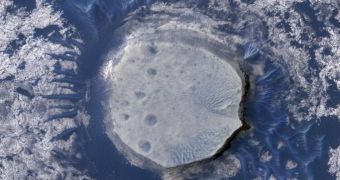Scientists at the NASA Jet Propulsion Laboratory (JPL) announce that the Mars Reconnaissance Orbiter (MRO) has just zipped past a very important milestone in its mission. It managed to reach a level of 100 terabytes of sent data, which is the rough equivalent of 35 hours of uncompressed, high-definition video. The 100 trillion bytes is a limit that was not thought possible a generation ago, and which puts the MRO among the most important space missions ever flown. It has been revolving around the Red Planet for about four years, and thus far managed to send back the most complete image of Mars ever produced.
“What is most impressive about all these data is not the sheer quantity, but the quality of what they tell us about our neighbor planet. The data from the orbiter's six instruments have given us a much deeper understanding of the diversity of environments on Mars today and how they have changed over time,” explains JPL MRO project scientist Rich Zurek. He adds that the amount of information the space probe managed to transmit to Earth so far is about three times larger than that sent by all other deep-space missions combined. These missions are the ones who went beyond the orbit of the Moon.
The MRO was launched atop an Atlas V-401 rocket delivery system, from the Space Launch Complex 41 facility, at the Cape Canaveral Air Force Station (CCAFS), in Florida. After take-off, on August 12, 2005, the spacecraft spent a little less than a year en route, finally reaching and inserting itself into Martian orbit on March 10, 2006. Its primary mission was to survey the Red Planet for more than 2 years, but since it managed to endure for twice that, and then some. Its six scientific instruments are responsible for surveying the surface, subsurface and atmosphere of our neighboring planet. The spacecraft also acts as a relay between the Martian rovers and NASA Mission Control.
“The capability to return enormous volumes of data enables these instruments to view Mars at unprecedented spatial resolutions. Half the planet has been covered at 6 meters (20 feet) per pixel, and nearly 1 percent of the planet has been observed at about 30 centimeters (1 foot) per pixel, sharp enough to discern objects the size of a desk. The radar, provided by Italy, has looked beneath the surface in 6,500 observing strips, sampling about half the planet,” the JPL experts say.
“Among the mission's major findings is that the action of water on and near the surface of Mars occurred for hundreds of millions of years. This activity was at least regional and possibly global in extent, though possibly intermittent. The spacecraft has also observed that signatures of a variety of watery environments, some acidic, some alkaline, increase the possibility that there are places on Mars that could reveal evidence of past life, if it ever existed,” they conclude.

 14 DAY TRIAL //
14 DAY TRIAL //